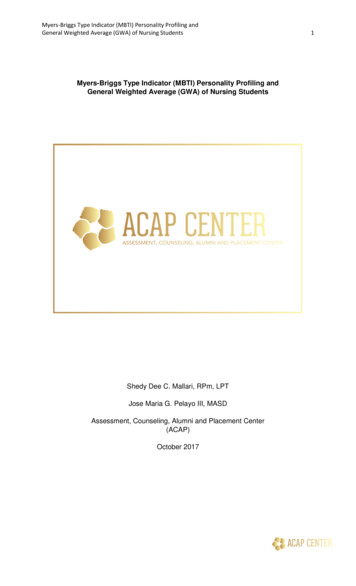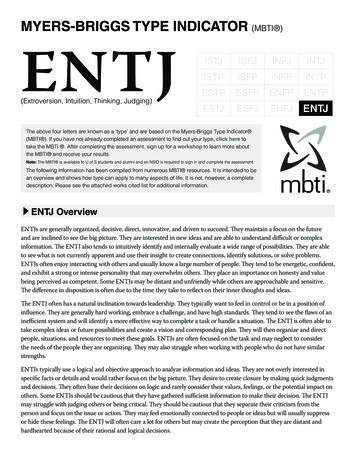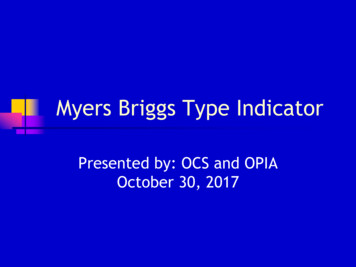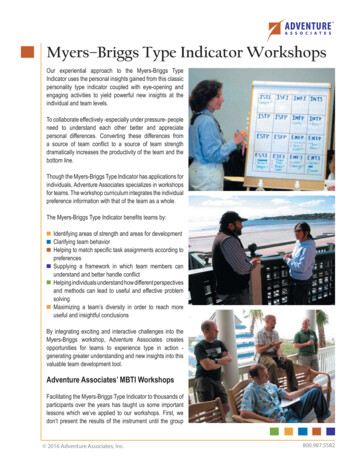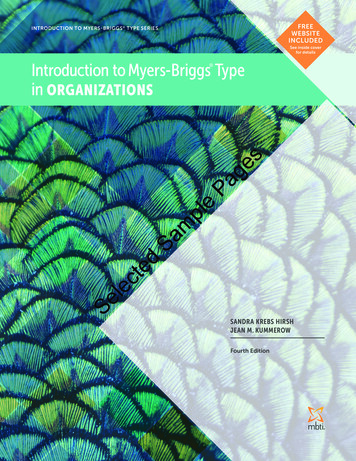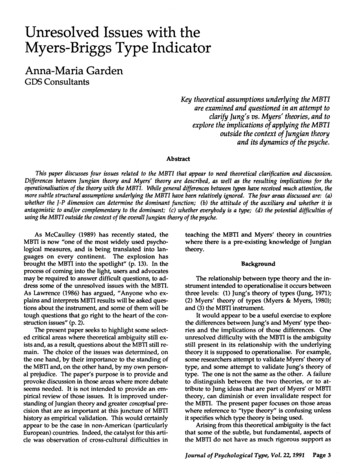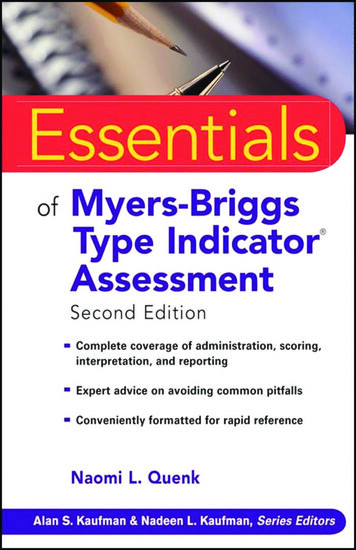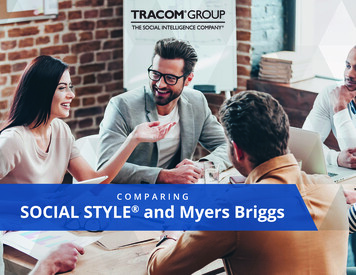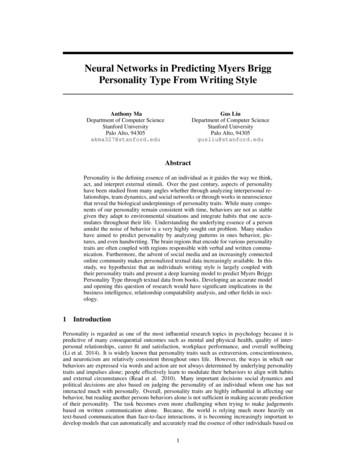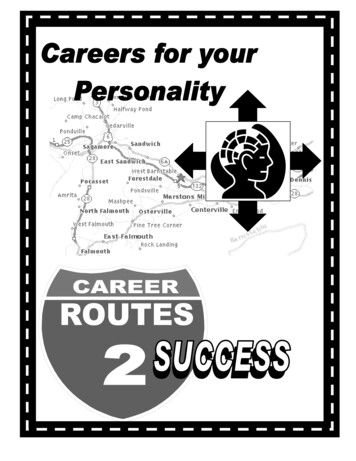
Transcription
Myers Briggs Type Indicator (MBTI)Summary The MBTI is a reliable and valid instrument that measures and categorizes yourpersonality and behavior. It is not a test. There are no “right” or “wrong” answers. Around 1940 a mother-daughter team (Katharine C. Briggs and her daughterIsabel Briggs Myers) developed this instrument to help people understand and useCarl Jung’s theory of psychological type preferences. Swiss Psychologist, Carl Jung, (1875 – 1961) theorized that you can predictdifferences in people’s behavior if you know how they prefer to use their mind.According to Jung, we each have an inborn preference for using our mind in oneof two different ways, in four different categories:Orientation to WorldTake in InformationMake DecisionsExtravertedEnergized by othersorIntrovertedEnergized by ideas,emotions, memoriesSensingUsing five sensesorIntuitionUsing gut or instinctsThinkingLogical, problem solversorFeelingConsider others,compassionateTake in Info. or DecidePerceivingTaking in informationorJudgingOrganizing informationand making decisions There are a total of 16 possible “types” based on unique combinations of thepreferences. Four letters are used to represent a type, for example a person with preferences forExtraverted, Sensing, Thinking, Judging is called an ESTJ. Each type has strengths and weaknesses. No type is better than another. People can use this assessment tool to validate their preferences on each of thefour dichotomies and understand the sixteen different personality types that resultfrom the interactions among preferences. Knowing your type can help you: choose a career that might be a good match for your personalityunderstand othersunderstand your own behaviorcommunicate better with otherswork more cooperatively in groups with othersmanage people better in a work situationappreciate individual differencesand more
Myers Briggs Type Indicator (MBTI)Self-“Guesstimate” WorksheetWhich side do you think more accurately describes you? Write the letter in the box at the end of each pair.Orientation to the WorldExtraversionFocus on the outer world of people and thingsReceive energy from interacting with peopleEnergized by taking action; activePrefer communicating by talking (over writing)Work out ideas by talking them throughLearn best through sharing/doing/discussingHave broad interestsIntroversionInternal focus on ideas, memories, or emotionReceive energy from reflecting on thoughtsPrefer communicating in writing (over talking)Learn best by having time alone to processPrefer working in quiet environmentsAble to focus on one project at lengthKnown to be reflective, quiet, private, or deepMy code:E or IPreference for Taking In Information (Perceiving)SensingFocus on the present; what is happening nowPrefer real/concrete/tangible informationAttentive to details, specifics, and factsEnjoy tasks with an orderly, sequential formatLike having five senses engaged while workingWork at a steady pace and have staminaKnown to be practical, steady, and orderlyiNtuitionFocus on future; possibilities and potentialSee the big picture, connections, or patternsRemember specifics when part of a patternImaginative and creativeBored by routine and sequential tasksLike solving problems and developing new skillsHave bursts of energy rather than staminaS or NPreference for Making Decisions (Judging)ThinkingExamine logical consequences of decisionsObjectively weigh the pros and consBase decisions on impersonal analysis and logicEnergized by problem solving and critiquingSeek standard principles to apply uniformlyLook for cause/effect relationships in dataConsider feelings when presented as factsFeelingBase decisions on subjective valuesEnjoy appreciating and supporting othersActively look for qualities to praise in othersValue and create harmonious environmentsHonor each person as a unique individualAssess impacts of decisions on othersWork best in supportive, encouraging settingsT or FPreference for Either Taking In Information or Making DecisionsJudgingPrefer to make decisions with informationMake decisions as soon as possibleEnjoy having closure; like things settledPlan and organize their worldLike roles and expectations to be clearEnjoy getting things done/being productivePlan ahead to avoid last minute stressesPerceivingPrefer to take in information and understandKeep things open-ended as long as possibleSeek to experience and live life; not control itOpen to new options and last-minute changesEnjoy starting projects but often never finishAble to adapt; flexibleEnergized by last minute pressuresJ or P
MBTI and Learning Styles and StrategiesExtroverts (E) are energized by interaction with others. They are people of action. Es are pulled intosocial life and find it difficult to settle down, read, or concentrate on homework. They may find collegetasks, such as reading, research, and writing challenging because they are solitary endeavors. They learnbest by talking and physically engaging in the environment. Extroverts learn better in small classroomsettings where students can actively engage in conversations with peers and professors as opposed tolarge lecture style classrooms where listening is the primary activity. Extroverts enjoy oral feedback fromprofessors, as well as conversations before/after class or during office hours. Additionally, extravertsbenefit from study groups where they can learn through speaking with others.Introverts (I) are energized by the inner world of reflection, thought, and contemplation. They needspace and time alone. Introverts like reading, lectures, and written work. Therefore, they generally do wellin traditional classroom settings. Introverts may hesitate to speak up in class but may benefit from one-onone conversations with a professor or written feedback. Online courses may work well for introverts asmany often engage more in chat rooms or via email than contributing orally to a class discussion.Introverts may need time alone to reflect, process, and reenergize before joining a group or study group.Sensing (S) people rely heavily on their five senses to take in information. They may be good listeners orvisually oriented learners. They also enjoy hands-on learning experiences. They like concrete facts,organization, and structure. They learn well from organized lectures or presentations. They are good atmemorization. Sensing people usually like outlines, clear guidelines, and specifics. A syllabus is animportant learning tool for Sensing types. As Sensing types often have difficulty with theory, they maystruggle in classes where theoretical concepts are commonplace such as psychology or philosophy.Intuitive (N) people see the world through intuition. They learn by hunches. Intuitive students may notread a test question all the way through, sometimes missing a key part. Intuitive types want to know thetheory before deciding that facts are important and will always ask "why". They are creative andinnovative and may struggle following strict sets of instructions or on multiple choice tests. Ns also workwith bursts of energy. Ns will write their term paper and then finish the required outline.Thinking (T) people decide on the basis of logic, analysis, and reason. They may be great at figuring outlogical problems and analyzing problems. They may voice their strong opinions in the classroom. Theyexpect fairness in grading, equal treatment of all students and adherence to fair classroom policies.Feeling (F) persons decide on the basis of their feelings, personal likes and dislikes. Feeling types valueharmony and are distressed by interpersonal friction. Harmony in the classroom, with classmates and withthe professor will be of ultimate importance for Feeling types.Judging (J) types try to order and control their world. They are decisive, may be closed-minded, and areusually well organized. They meet deadlines, like planning, and prefer to work on only one thing at atime. Judging types will usually have very well organized notebooks, and will structure their time tocomplete assignments promptly. Judging types will struggle if changes occur and they need to adapt, or ifthey are required to work with a group that is not as well organized, or if they need to cram for an exam.Perceiving (P) types are spontaneous and don't like to be boxed in by deadlines or plans. They want togather more information before making a decision. They work at many things at once. Ps are flexible andoften good in emergencies when plans are disrupted. Their biggest problem is procrastination. Ps mayhave trouble getting assignments in on time or budgeting their time. They may, however, actually do wellcramming for an exam or rushing to get a project finished as they thrive on last-minute pressure.
Communicating with MBTI PreferencesWhen communicating with ExtrovertsTalk to them, preferably face to facePresent information to extroverts in groups as they will like to talk about it with each otherEmphasize the action to be takenExpect extroverts to toss ideas out and speak up in group situationsWhen communicating with IntrovertsPut in writing – send an email instead of callingPresent to them individually or in small groupsGive them time to reflect on their thoughts after receiving information and before sharing their ideas witha groupWhen communicating with Sensing TypesClearly present your topic in an orderly formatGive lots of details, facts and concrete examplesUse props, multimedia, or samples to help them see, hear, smell, touch, or taste your ideasFocus on the tangible, practical results that can be achieved in the short termWhen communicating with Intuitive Types (Ns)Discuss the big picture and long-term possibilitiesEmphasize ideas/concepts instead of detailsIf you must mention specifics, do so using patterns and emphasize their connectionsGive them a problem to solve and allow them room to be innovative, novel and creativeWhen communicating with Thinking TypesBe brief – get to the pointUse logical (not emotional) arguments to appeal to the head, not the heartClearly identify any pros or cons to be weighedAllow them time to critiqueExpect them to be fairWhen communicating with Feeling TypesCreate a supportive, friendly environmentBegin with words of appreciation and identify areas of agreementUse emotional arguments instead of logic and emphasize the effect on people involvedSelf-disclose with personal anecdotes or examplesWhen communicating with Judging TypesBe prompt (or early) and stick to a schedulePresent information in an organized mannerEmphasize deadlines and timetablesExpect decisions to be made quicklyDon’t include surprisesWhen communicating with Perceiving TypesExpect to have funLeave extra time to actually get work done; a deadline will not really be perceived as the deadlinePresent information as options that are modifiable and let them draw conclusionsCapitalize on their natural last-minute energy
Celebrity MBTIsESTJ(The Supervisor)George W. BushNolan RyanJudge JudyDr. Laura SchlesingerLucy (Peanuts character)ISTJ(The Investigator/Inspector)Queen Elizabeth IIHarry TrumanEvander HolyfieldJack NicklausCliff Clavin (Cheers)ESTP(The Opportunist/Promoter)Ernest HemingwayLucille BallPedro MartinezEddie MurphyMadonnaDonald TrumpISTP(The Athlete/Crafter)Ted WilliamsBruce LeeRoger ClemensLarry BirdMichael JordanAllen IversonESFJ(The Facilitator/Provider)George WashingtonBarbara WaltersTerry BradshawMary Tyler MooreSally FieldMonica (Friends)ISFJ(The Assistant/Protector)Louisa May AlcottDavid CopperfieldOphelia (Hamlet)Johnny CarsonJerry SeinfeldESFP(The Entertainer/Performer)Bob HopeGoldie HawnKyle PettyMagic JohnsonCharles BarkleyBill ClintonISFP(The Artisan/Composer)MozartNeil SimonPaul McCartneyPaul PierceBrooke ShieldsENFJ(The Educator/Teacher)Diane SawyerOprah WinfreyMartin Luther King, Jr.Lauren Graham (Gilmore Girls)Ben AffleckINFJ(The Wordsmith/Counselor)AristophanesMohandas GandhiEleanor RooseveltMichael LandonQueen NoorENFP(The Motivator/Champion)Dave Thomas (Wendy's)Meg RyanRegis PhilbinDr. Doug Ross (ER)Ariel (The Little Mermaid)INFP(The Idealist/Healer)Helen KellerFred Rogers (Mister Rogers)James TaylorAmy TanCalvin (Calvin and Hobbes)ENTJ(The CEO/Field Marshal)Napoleon BonaparteRichard M. NixonSigourney WeaverMargaret ThatcherAlan GreenspanINTJ(The Inventor/Mastermind)Ulysses S. GrantArnold SchwarzeneggerRudy GiulianiDonald RumsfeldGeneral Colin PowellENTP(The Strategizer/Inventor)Benjamin FranklinWalt DisneyRed AuerbachVin BakerBugs BunnyINTP(The Logician/Architect)SocratesCharles DarwinAlbert EinsteinMikhail BaryshnikovNelson MandelaSteven Spielberg
Myers Briggs Type Indicator (MBTI) Summary The MBTI is a reliable and valid instrument that measures and categorizes your personality and behavior. It is not a test. There are no “right” or “wrong” answers. Around 1940 a mother-daughter team (Katharine C. Briggs and her daughterFile Size: 2MB
